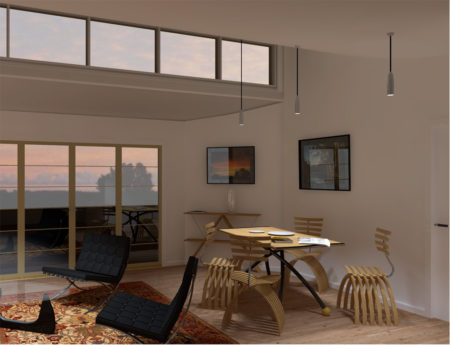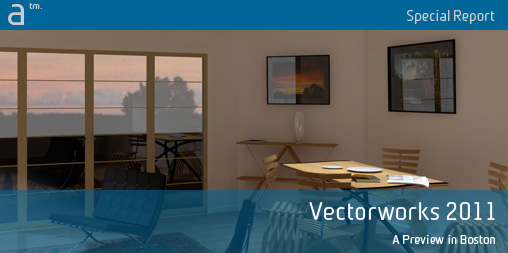Continued from page 2
BIM improvements don’t stop there though. There is a new Connect Roof Faces command and dramatic stair tool improvements. IFC support has been improved and updated for interoperability with other BIM tools. And lastly, architects who care about computer-generated renderings will be super pleased to see that the company has incorporated Maxon’s CINEMA 4D engine into Renderworks. Speaking of which, we asked Dr. Biplab Sarkar to further explain that decision.
AFR: Why CINEMA 4D engine now?
DBS: We felt that it gave us superior quality and performance over Lightworks. And it is a part of our Nemetschek Group’s overall technology prowess. (see image 3)

03 - Vectorworks 2011 now features the Cinema 4D rendering engine in lieu of Lightworks in its Renderworks add-on application option.
AFR: Does the new Send to CINEMA 4D Command replace the CINEMA 4D – VW plugins?
DBS: Yes, this new command is the preferred way to work with CINEMA 4D now.
AFR: Are the Camera options in Renderworks coming entirely over from CINEMA 4D? Do they match what is possible in C4D?
DBS: Renderworks cameras were introduced in Renderworks 2009 and its settings are not the same as CINEMA 4D cameras but are similar. We don’t export the Renderworks Camera object as a CINEMA 4D object right now, but I can see this as a useful future enhancement. We only export the current view at present.
AFR: Are there any new OpenGL improvements and what of OpenGL 3?
DBS: The most significant change in OpenGL is this version is the support for planar objects. OpenGL rendering now supports the rendering of objects on working planes with their specific attribute settings, including texts and dimensions.
AFR: Can you explain the feature of DXF/DWG Export into Design Layer Viewports? What do you mean by entirely bound into the current drawing? Is this related to the use of a Shuttle File as presented back in Vectorworks 2008?
DBS: In Vectorworks 2010, Design Layer viewports (DLVP) were always exported to DXF/DWG as separate DWG files and were referenced from the master DXF/DWG file. In Vectorworks 2011 users have the option of choosing between creating separate DWG files for each DLVP or automatically including its content into the currently exported document. This helps customers who have trouble with managing many multiple files.
Other Features and Benefits for Vectorworks 2011
Vectorworks 2011 has a plethora of new smaller features that add up. There are new Tile Fills for 2D objects, Saved Settings of the Eyedropper tool, and a great new dividing lines command. CAD managers will also like the new option to replace existing classes during a class import. This will aid office standards enforcement as well as provide useful flexibility in the appearance of files and drawings.
For LandMark there is a powerful new Retaining Wall Site Modifier feature. This will aid the accuracy of cut and fill calculations. There is a new Create Stepped Wall command plus new Grade and Existing Tree tools.
When it comes to terrain modeling Vectorworks 2011 does not use the Parasolid modeling engine. “Most of the operations in terrain modeling are not driven by Parasolid,” said Dr. Biplab Sarkar. “This is mostly because of the trade-off between speed and accuracy.” Landmark has many more improvements than we are mentioning here so please visit Nemetschek’s website to learn more.
Spotlight also has interesting new features, including new options for seating layouts and better focus point support for lighting instruments. A big new change with the Vectorworks 2011 product line is the elimination of Vectorworks Machine Design. The company said this was the least successful product for them and it is not worth promoting as a separate application. Vectorworks 2011’s base 2D/3D capabilities continue to make it a solid choice for machine design work.
Closing Comments
Nemetschek Vectorworks looks to have produced a very compelling update to its flagship product line. Sending such senior brass up to Boston to meet me to show me this upcoming 2011 release was a sign that the company had something really special to show. I would remiss if I didn’t summarize these milestone improvements in the recent history of the product.
For starters Vectorworks 2011 marks the conclusion of the company’s adoption of the Parasolid geometry modeling kernel. This is no small achievement and places Vectorworks on the leading edge of solid and surface modeling technology in the CAD and BIM space. Now the company is in the enviable position, having fully implemented the kernel, to push its future capabilities as a customer of Siemens PLM Parasolid technology, molding them to the needs of its users.
Secondly, Vectorworks 2011 marks a significant point in its development history with the adoption of the new Planar surfaces workflow which Dr. Biplab Sarkar has so elegantly described. This flexibility with 2D/3D tools in various views or orientations, plus the ability to draft in 3D, is remarkable. In fact, we were touting the ability to draft in 3D and utilize 3D text in our discussions of BoA nearly ten years ago. We saw that as valuable and important then and feel it is just as much today. Other than BoA, I’m not sure what other program out there allows you to place text and symbols in 3D.
Thirdly, the Push/Pull and Face Selection Feedback features that are new in Vectorworks 2011 seriously put pressure on competing modelers which are popularly utilized alongside Vectorworks-centered workflows. This would include SketchUp as much as Bonzai 3D.
Fourthly, for years many observers and CAD analysts and pundits have wondered why the Nemetschek Group did not produce more synergies between its various sister companies and their technology. The relationship between Maxon’s CINEMA 4D and its fleet of BIM programs being a prime example. Vectorworks 2011 actually takes the bold step many have imagined by integrating the CINEMA 4D’s rendering engine directly into Renderworks. This is one of the nicest things they have added to this release.
Those are four major milestones in the development of this release. And to top it all off there are dozens and dozens of new features and improvements sprinkled throughout the product. Vectorworks 2011 is a landmark achievement for the America-based, German-owned software company. To learn more visit them online here.




Reader Comments
[…] This post was mentioned on Twitter by Neal Pann, Architect and Anthony Frausto, Anthony Frausto. Anthony Frausto said: Vectorworks 2011 – A Preview in Boston http://t.co/sXYbHCX This is a new feature article on Architosh covering this important update […]
Comments are closed.